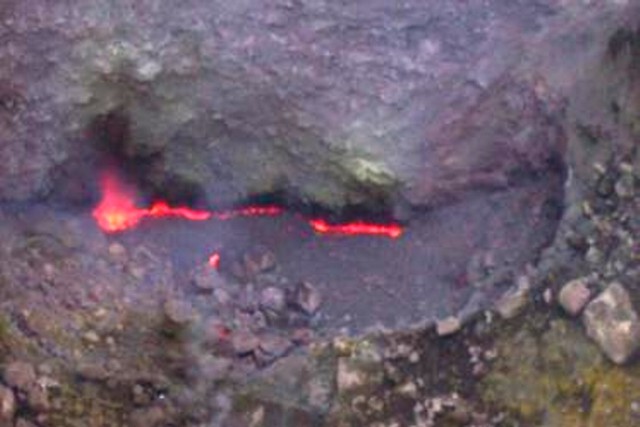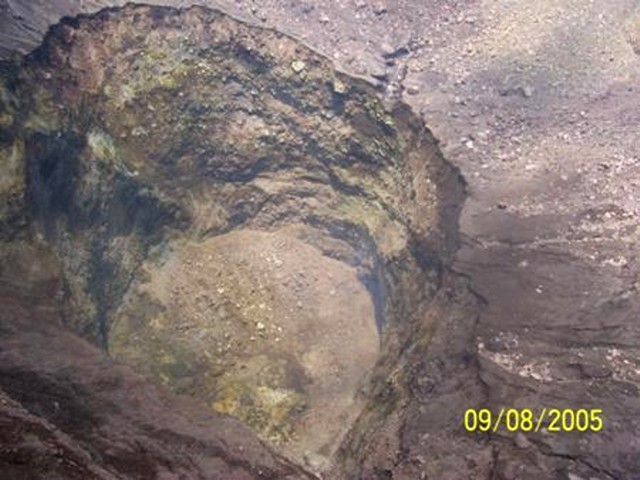Report on Telica (Nicaragua) — June 2009
Bulletin of the Global Volcanism Network, vol. 34, no. 6 (June 2009)
Managing Editor: Richard Wunderman.
Telica (Nicaragua) Intermittent incandescence and ash explosions through January 2005
Please cite this report as:
Global Volcanism Program, 2009. Report on Telica (Nicaragua) (Wunderman, R., ed.). Bulletin of the Global Volcanism Network, 34:6. Smithsonian Institution. https://doi.org/10.5479/si.GVP.BGVN200906-344040
Telica
Nicaragua
12.606°N, 86.84°W; summit elev. 1036 m
All times are local (unless otherwise noted)
Intermittent ash explosions and crater incandescence were seen during 2000-2002, along with high levels of seismicity related to degassing and constant low tremor (BGVN 34:05). Strong gas emissions were typical in the first half of 2003, with incandescence often noted later in the year. Activity during 2004 included occasional ash explosions as well as incandescence. After small ash explosions in late January 2005 no volcanism was noted for the remainder of the year, with observers primarily noting crater wall collapses and degassing. The Nicaraguan Territorial Studies Institute (INETER) monitors activity; visits to the crater described below are by INETER staff (primarily Pedro Perez) unless otherwise noted, though scientists from other institutions may have also been present. Some observations were also made by a local resident who maintains the local seismic station.
Activity during 2003. In January 2003 gas emissions at Telica fluctuated in their intensity. Dense gas prevented observations of incandescence. During a crater visit on 6 May an observer heard a pressurized sound, smelled sulfur, and saw blue gases. Eucalyptus trees 2 km E of the crater appeared to have been burned by the acidic gases. There was a bluish glow in the crater on 25 June and a strong smell of sulfur. To the W of the volcano several trees dropped the bulk of their leaves due to acid rain. Gas emissions remained almost constant at a moderate level.
On 31 July a high pressure noise was heard and incandescence was observed in the center of the crater. Pressurized gases emerging on 22 August from the vent at the bottom of the crater emitted a loud, jet-like sound. As in July, the vent also showed incandescence and emitted a sulfur odor. Satellite images on 24 September showed a column of gas. On 7 October incandescent was again observed, along with a strong odor of sulfur. There was a collapse of material in the SE sector.
Activity during 2004. On 20 January 2004 a wavelike sound was heard, open fissures emitted little gas, and glow was observed in the crater (figure 14). A small ash explosion on 31 March at about 0856 was reported by the caretaker of the Tel3 seismic station. On 28 April an observer noted that internal collapses had covered almost half of the southern part of the crater floor with debris. As a result incandescence in the crater was difficult to detect.
 |
Figure 14. Photograph of the crater at Telica, showing incandescence on 20 January 2004. Courtesy of P. Perez (INETER). |
A seismic swarm N of Telica lasted from 9 to 14 June. The earthquakes had magnitudes up to 2.4 and depths between 1 and 9 km, with some being felt by local residents in the Aguas Calientes area. On 28 June a seismic signal similar to that of an explosion was detected. INETER received no reports of ashfall in surrounding areas. Reports for July-September were not available. Ash explosions occurred from the crater on 5 and 11 November. On 10 December there was significant gas and ash output, with sounds of breaking rocks inside the crater. Unlike the previous months, no incandescence was seen.
Activity during 2005. On 29 January 2005 the volcano produced small ash explosions with abundant gases. The next day when INETER technician Pedro Pérez visited he heard jet-like sounds and smelled strong gas emissions. Low gas emissions persisted during February-April. On 15 May a small earthquake swarm lasted about ten hours. Observers to the crater on 1 May noted small blue gas emissions and sulfur odor, but no incandescence. Collapses were also seen in the W and S portions of the crater.
On 30 June observers saw minor gas emissions and new material in the eruptive fissure from crater wall collapses. Activity was low on 9 August (figure 15), no sounds heard, but the crater walls had some precipitates from the gas emissions. On a 7 September visit additional collapses of the crater walls were observed along with significant gas emission. Small gas emissions were observed by a monitoring webcam for almost the entire month of December.
 |
Figure 15. Photograph showing the Telica crater on 9 August 2005. Rockfall debris from crater wall collapses can be seen on the crater floor. Courtesy of P. Perez (INETER). |
Geological Summary. Telica, one of Nicaragua's most active volcanoes, has erupted frequently since the beginning of the Spanish era. This volcano group consists of several interlocking cones and vents with a general NW alignment. Sixteenth-century eruptions were reported at symmetrical Santa Clara volcano at the SW end of the group. However, its eroded and breached crater has been covered by forests throughout historical time, and these eruptions may have originated from Telica, whose upper slopes in contrast are unvegetated. The steep-sided cone of Telica is truncated by a 700-m-wide double crater; the southern crater, the source of recent eruptions, is 120 m deep. El Liston, immediately E, has several nested craters. The fumaroles and boiling mudpots of Hervideros de San Jacinto, SE of Telica, form a prominent geothermal area frequented by tourists, and geothermal exploration has occurred nearby.
Information Contacts: Wilfried Strauch, Instituto Nicaraguense de Estudios Territoriales (INETER), Apartado Postal 2110, Managua, Nicaragua (URL: http://www.ineter.gob.ni//geofisica.html).

